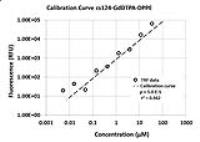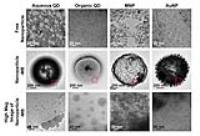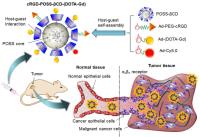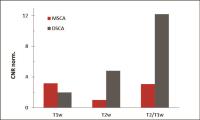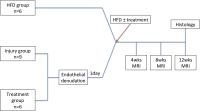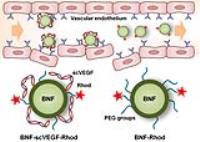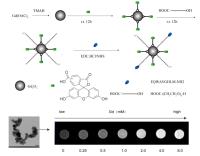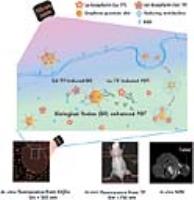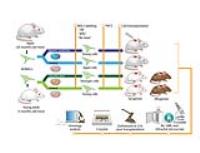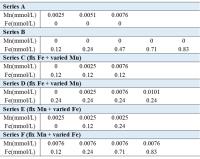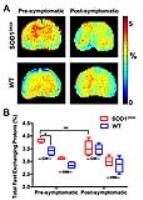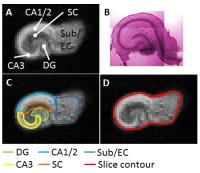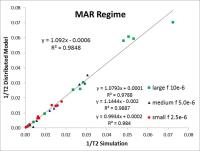|
2328.
 |
Development of Calibrationless Parallel Imaging Methods for
Clinical Hyperpolarized Carbon-13 MRI Studies
Yesu Feng1, Jeremy Gordon1, Peter Shin1,
Cornelius von Morze1, Michael Lustig2,
Peder E.Z. Larson1, Michael A. Ohliger1,
Lucas Carvajal1, James Tropp3, John M
Pauly4, and Daniel B. Vigneron1
1Radiology and Biomedical Imaging, UCSF, San
Francisco, CA, United States, 2EECS,
UC Berkeley, Berkeley, CA, United States, 3GE
Healthcare, Fremont, CA, United States, 4Electrical
Engineering, Stanford, Stanford, CA, United States
Hyperpolarized (HP) 13C imaging requires fast data
acquisition due to the fast T1 relaxation. Parallel imaging
methods are well suited for acceleration of data
acquisition, yet conventional parallel imaging schemes
require explicit calibration of coil sensitivity which
presents significant challenge to HP 13C imaging. In this
study, a calibrationless parallel imaging method was tested
and applied to HP 13C MRI. A 2-fold acceleration was
achieved when this technique was applied together with a 2D
EPI readout. This strategy is being extended for 3D HP 13C
EPI for improved volumetric coverage and better temporal
resolution for future clinical studies.
|
|
2329.
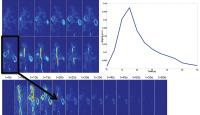 |
Using a Low Rank plus Sparse Reconstruction Approach to
Accelerate 3D Dynamic bSSFP Hyperpolarized Carbon-13 MR Imaging 
Eugene Milshteyn1, Cornelius von Morze1,
Galen D Reed2, Hong Shang1, Peter J
Shin1, Peder EZ Larson1, and Daniel B
Vigneron1
1Radiology and Biomedical Imaging, UCSF, San
Francisco, CA, United States, 2HeartVista,
Menlo Park, CA, United States
Hyperpolarized 13C
MR can provide unique imaging assessments of metabolism and
perfusion in various disease conditions in
vivo. High spatiotemporal resolution is needed to best
characterize these processes. This project used a low rank
plus sparse reconstruction with the bSSFP acquisition to
achieve high isotropic resolution dynamic 3D imaging with
multiple hyperpolarized substrates.
|
|
2330.
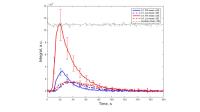 |
Direct arterial injection of hyperpolarized compounds into tumor
tissue enables rapid detection of metabolism with minimal
dilution
Steven Reynolds1, Stephen Metcalf2,
Rebecca Collins3, Edward Cochrane3,
Simon Jones3, Martyn Paley1, and
Gillian Tozer2
1Academic unit of radiology, University of
Sheffield, Sheffield, United Kingdom, 2Department
of Oncology and Metabolism, University of Sheffield,
Sheffield, United Kingdom, 3Department
of Chemistry, University of Sheffield, Sheffield, United
Kingdom
Hyperpolarizing drug candidates could allow insights into
their mode of action and metabolic fate. However,
administering drug molecules at high concentrations can lead
to adverse effects in animals. We have developed a method
for directly administering substrates to tumor tissue by
infusion through a single supplying artery, thus maximizing
tumor drug delivery and minimizing T1 relaxation and
systemic toxicity. The net signal gain for arterially
injected 13C-pyruvate
was x54, compared with the systemically administered venous
route. Hyperpolarized custom 13C-labeled
CA1 was arterially administered and its parent peak
observed, in
vivo, at its expected chemical shift (58ppm).
|
|
|
|
|
2331.
 |
Characterisation of adipose tissue-derived mesenchymal stem cell
using hyperpolarized MRS
Anja Bille Bohn1, Nathalie Nielsen2,
Christoffer Laustsen2, Hans Stødkilde-Jørgensen2,
and Lotte Bonde Bertelsen2
1The department of Clinical Immunology, Aarhus
University Hospital, Aarhus, Denmark, 2MR
Research Centre, Aarhus University, Aarhus University
Hospital, Aarhus, Denmark
Synopsis: Studies of metabolism in stem cells have revealed
a shift in the balance between glycolysis, mitochondrial
oxidative phosphorylation and oxidative stress during the
maturation of stem cells. In the stem cells, pyruvate from
glycolysis will mainly be metabolized to lactate as a result
of an uncoupling of the citric acid cycle and the oxidative
phosphorylation pathway, thus the application of a novel
metabolic cell culture tool could add valuable information
to the studies of stem cell characterisation during
development. In the present study we use hyperpolarised
[1-13C] pyruvate to characterise mesenchymal stem cells
harvested from adipose tissue.
|
|
2332.
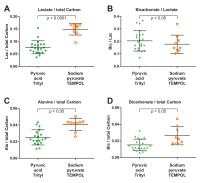 |
The formulation of hyperpolarized 13C
pyruvate solutions influences the labeling of myocardial
metabolites in vivo 
Hikari A. I. Yoshihara1, Jessica A. M.
Bastiaansen2, Corinne Berthonneche3,
Arnaud Comment1, and Juerg Schwitter4
1Institute of Physics of Biological Systems,
Swiss Federal Institute of Technology (EPFL), Lausanne,
Switzerland, 2Department
of Radiology, University Hospital Lausanne (CHUV) and
University of Lausanne (UNIL), Lausanne, Switzerland, 3Cardiovascular
Assessment Facility, University Hospital Lausanne (CHUV),
Lausanne, Switzerland, 4Division
of Cardiology and Cardiac MR Center, University Hospital
Lausanne (CHUV), Lausanne, Switzerland
In developing an intact rat model for myocardial ischemia
using hyperpolarized 13C
pyruvate, different compound formulations were evaluated.
Infusion of 4-hydroxy-TEMPO-polarized sodium [1-13C]pyruvate
was compared to an equivalent dose of buffered trityl
radical-polarized [1-13C]pyruvic acid. Whereas
higher levels of polarization and MRS signal were obtained
with trityl radical, the metabolite signals normalized to
total signal were lower. In particular, [1-13C]lactate
signal relative to total signal was markedly higher using
TEMPO-polarized pyruvate. [13C]bicarbonate and
[1-13C]alanine signals were affected to a lesser
degree. This study demonstrates the composition of the
infused hyperpolarized pyruvate solution can significantly
affect its metabolism in vivo.
|
|
2333.
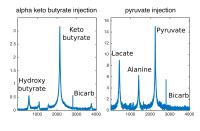 |
Rapid decarboxylation of hyperpolarized [13C]ketobutyrate in
mouse liver in vivo
Cornelius von Morze1, Irene Marco-Rius1,
Celine Baligand1, Robert Bok1, John
Kurhanewicz1, Daniel Vigneron1, and
Michael Abram Ohliger1,2
1Radiology and Biomedial Imaging, University of
California San Francisco, San Francisco, CA, United States, 2UCSF
Liver Center, San Francisco, CA, United States
We investigate the rapid metabolic conversion of
hyperpolarized (HP) [1-13C]α-ketobutyrate, a molecular
analog of pyruvate, in mouse liver in vivo as compared to
[1-13C]pyruvate. Previously, it has been noted that in
liver, there is relatively less conversion of
[1-13C]α-ketobutyrate to its reduction product,
[1-13C]hydroxybutyrate when compared to the conversion of
[1-13C]pyruvate to [1-13C]lactate. This difference in
conversion likely represents a different LDH activity in
liver1. In this study, we examine the decarboxylation of
ketobyrate into bicarbonate, which we have found to be
unexpectedly elevated when compared to pyruvate, presumably
also via PDH and/or a related enzyme.
|
|
2334.
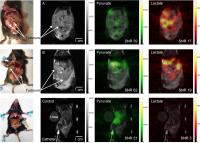 |
Intraperitoneal substrate administration for ¹³C metabolic
imaging in a mouse model of abdominal metastasis 
Justin Y.C. Lau1,2, Aws Abdul-Wahid3,
Albert P. Chen4, Jean Gariépy1,3, and
Charles H. Cunningham1,2
1Medical Biophysics, University of Toronto,
Toronto, ON, Canada, 2Physical
Sciences, Sunnybrook Research Institute, Toronto, ON,
Canada, 3Biological
Sciences, Sunnybrook Research Institute, Toronto, ON,
Canada,4GE Healthcare, Toronto, ON, Canada
Conventionally, hyperpolarized 13C
substrates are administered via intravenous injection. In
this abstract, a novel route of hyperpolarized substrate
delivery via intraperitoneal injection is demonstrated for
observing metabolism in a mouse model of abdominal
metastasis. 2D CSI revealed lactate signal in tumour-bearing
mice, but only pyruvate signal in a control mouse. An
extended time window of dynamic metabolic imaging may be
possible with intraperitoneal administration due to the
longer in vivo pyruvate T1 of
54 s as measured by dynamic 3D EPI. Intraperitoneal
administration of hyperpolarized 13C
substrates is a promising complementary technique well
suited for observing poorly vascularized metastatic nodules.
|
|
2335.
|
In vivo Assessment of Metabolic Derangements in Renal
Ischemia-Reperfusion Injury using Carbon-13 HP-MRI
Mehrdad Pourfathi1,2, David D. Aufhauser3,
Douglas R. Murken3, Zhonglin Wang3,
Stephen J. Kadlecek1, Heather Gatens1,
Ali Naji3, Matthew H. Levine3,4, and
Rahim R. Rizi1
1Radiology, University of Pennsylvania,
Philadelphia, PA, United States, 2Electrical
and Systems Engineering, University of Pennsylvania,
Philadelphia, PA, United States, 3Department
of Surgery, Division of Transplant Surgery, University of
Pennsylvania, Perelman School of Medicine, Philadelphia, PA,
United States, 4Department
of Surgery, Children's Hospital of Philadelphia,
Philadelphia, PA, United States
Renal ischemia repercussion injury (IRI) and its
manifestation of acute kidney injury (AKI) is a significant
source of morbidity in diverse medical and surgical
scenarios, for which for which there is no current
therapeutic modality. AKI contributes significantly to
hospital stay, morbidity, and mortality. Despite the
extensive metabolic derangements that accompany renal IRI,
there is an absence of clinically useful markers to predict
the clinical course following AKI in an expedient manner.
Here, we demonstrate the feasibility of using hyperpolarized
carbon-13 MRI to image metabolic activity in the mice
recovering from renal IRI.
|
|
2336.
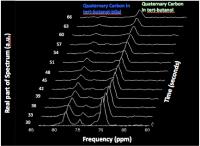 |
[13C]-tert-butanol-2-ß-D-galactose: A potential new
hyperpolarized imaging agent for in vivo imaging of senescent
cells
Keshav Datta1,2, Shie-Chau Liu1,
Stephen R Lynch3, Zixin Chen1, Ralph
Hurd4, Jianghong Rao1, and Daniel Mark
Spielman1,2
1Dept. of Radiology, Stanford University,
Stanford, CA, United States, 2Dept.
of Electrical Engineering, Stanford University, Stanford,
CA, United States, 3Dept.
of Chemistry, Stanford University, Stanford, CA, United
States, 4Applied
Sciences Lab, GE Healthcare, Menlo Park, CA, United States
We evaluated the potential for the use of
([13C]-tert-butanol-bGal as hyperpolarizeable agent for in
vivo imaging of senescent cells. The chemical shift
between [13C]-tert-butanol-bGal and bGal-cleaved
[13C]-tert-butanol was found to be 7.4ppm, more than
adequate for in vivo detection. [13C]-tert-butanol-bGal was
also found to polarize well(~30%) with
[13C]-tert-butanol-bGal and [13C]-tert-butanol yielding T1
relaxation times of 22s and 34s respectively, very promising
for in vivo studies.
|
|
2337.
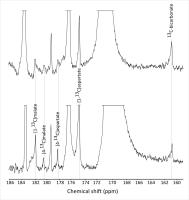 |
Concentration-dependent hepatic metabolism in vivo using a near
physiological dose range of hyperpolarized [1-13C]pyruvate
Emine Can1, Jessica A. M. Bastiaansen2,3,
Hikari A. I. Yoshihara4,5, Rolf Gruetter3,5,6,
and Arnaud Comment1
1Institute of Physics of Biological Systems,
École Polytechnique Fédérale de Lausanne (EPFL), Lausanne,
Switzerland, 2Department
of Radiology, University Hospital Lausanne (CHUV), Lausanne,
Switzerland,3Department of Radiology, University
of Lausanne (UNIL), Lausanne, Switzerland, 4Institute
of Physics of Biological Systems, EPFL, Lausanne,
Switzerland, 5Laboratory
for Functional and Metabolic Imaging, EPFL, Lausanne,
Switzerland, 6Department
of Radiology, University of Geneva, Geneva, Switzerland
Hyperpolarized 13C-labeled
pyruvate provides assessment of real-time liver
mitochondrial enzymatic activities directly by labeling TCA
cycle intermediates. However the technique is limited by the
requirement of supraphysiological concentrations due to the
low basal concentrations of metabolic intermediates. In this
study we showed the feasibility of detecting liver
metabolism in
vivo with HP 13C
pyruvate administered at plasma concentrations of at most
7-fold of the basal levels. Different metabolic response to
the concentration change shows that the adaptation to
supraphysiological levels can obscure feeding
state-depending metabolic differences in liver.
|
|
2338.
 |
Pool size effects in experiments with hyperpolarized [13C]ketobutyrate
Cornelius von Morze1, Peder E Larson1,
Michael A Ohliger1, Ralph E Hurd2,
John Kurhanewicz1, and Daniel B Vigneron1
1Department of Radiology and Biomedical Imaging,
University of California, San Francisco, San Francisco, CA,
United States, 2GE
Healthcare, Menlo Park, CA, United States
The purpose of this abstract was to investigate pool size
effects in experiments with hyperpolarized [13C]α-ketobutyrate
(αKB), a molecular analog of pyruvate which also has
substantial activity with LDH. In contrast to pyruvate,
formation of the reduction product [13C]α-hydroxybutyrate
(αHB) necessarily reflects net metabolic flux as opposed to
label exchange. We observed little change when co-injecting
αHB but a large increase in the αHB-to-αKB ratio when
co-injecting lactate. This suggests that the observed
conversion of αKB to αHB only reflects net metabolic flux
even in the presence of a large pool of reduction product.
|
|
2339.
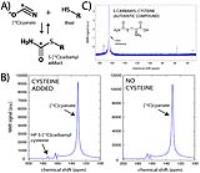 |
Feasibility of sensing small molecule thiols using
hyperpolarized [13C]cyanate
Cornelius von Morze1, Chloe Najac1,
Robert R Flavell1, David E Korenchan1,
Pavithra Viswanath1, Lucas Carvajal1,
John Kurhanewicz1, Sabrina M Ronen1,
Daniel B Vigneron1, and David M Wilson1
1Department of Radiology and Biomedical Imaging,
University of California, San Francisco, San Francisco, CA,
United States
The purpose of this study was to show basic feasibility of
non-invasively detecting small molecule thiols using
hyperpolarized [13C]cyanate. We detected rapid
formation of the expected hyperpolarized S-[13C]carbamyl
thiol adduct after adding cysteine to liquid hyperpolarized
[13C]cyanate samples. This work demonstrates a
new non-enzymatic approach for detecting small molecule
thiols such as reduced glutathione, which could be very
useful for research on oxidative stress.
|
|
2340.
 |
13C dynamic nuclear polarization NMR for quantification of
metabolic flux of endothelial progenitor cells
Nathalie Nielsen1, Christoffer Laustsen1,
Hans Stødkilde-Jørgensen1, and Lotte Bonde
Bertelsen1
1MR Research Centre, Department of Clinical
Medicine, Aarhus University Hospital, Aarhus University,
Aarhus, Denmark
This study aims to quantify the metabolic flux in EPCs in
order to characterize the metabolic changes occurring during
in-vitro culturing utilized for cell expansion, 3D scaffolds
and suspension. [1-13C] hyperpolarized pyruvate
is injected to a NMR compatible bioreactor system and the
conversion is detected and measured as the lactate/pyruvate
ratio. Activation assays and qPCR is performed to support
the results. The lactate/pyruvate (6±1,07 fold) and LDH
activity is increased in cell suspension culturing. Together
with an elevated PDH expression in suspension cultures our
conclusion is that adherent cells metabolically compensate
in the suspension culture due to the environmental
conditions.
|
|
2341.
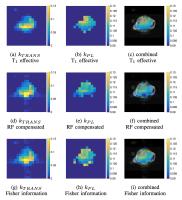 |
Optimizing flip angles for metabolic rate estimation in
hyperpolarized carbon-13 MRI 
John Maidens1, Jeremy W. Gordon2,
Murat Arcak1, and Peder E. Z. Larson2
1Electrical Engineering & Computer Sciences,
University of California, Berkeley, Berkeley, CA, United
States, 2Radiology
& Biomedical Imaging, University of California, San
Francisco, San Francisco, CA, United States
Hyperpolarized carbon-13 MRI experiments typically aim to
distinguish between healthy and diseased tissues based on
the rate at which they metabolize an injected substrate.
Existing approaches to determine flip angle sequences for
kinetic measurements have used metrics such as signal
variation and signal-to-noise ratio, but are not optimized
to provide the most reliable metabolic rate estimates. Here
we present a flip angle sequence that maximizes the Fisher
information about the metabolic rate. We demonstrate through
numerical simulation that flip angle sequences optimized
using the Fisher information lead to lower variance in
metabolic rate estimates than existing sequences. We then
validate this optimized sequence in
vivo with
experiments in a prostate cancer mouse model.
|
|
2342.
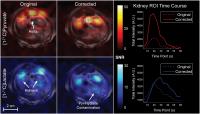 |
Dual-Echo EPI Sequence for Integrated Distortion Correction in
3D Time-Resolved Hyperpolarized 13C MRI
Benjamin J. Geraghty1,2, Albert P. Chen3,
and Charles H. Cunningham1,2
1Physical Sciences, Sunnybrook Research
Institute, Toronto, ON, Canada, 2Dept.
of Medical Biophysics, University of Toronto, Toronto, ON,
Canada, 3GE
Healthcare, Toronto, ON, Canada
A novel dual echo EPI sequence is proposed for providing a
built-in correction for off-resonance in time resolved,
volumetric hyperpolarized 13C
metabolic mapping with [1-13C]pyruvate. The phase
evolution between two echoes was used to correct EPI
distortion and improve spatial registration with the
underlying anatomy. A correction term obtained from a fully
phase encoded dual echo EPI proton reference scan was
required to account for odd/even echo asymmetry in the 13C
phase maps. Proof-of-concept dual echo EPI in vivo rat data
was acquired on a clinical 3T MR scanner and corrected
images are presented.
|
|
2343.
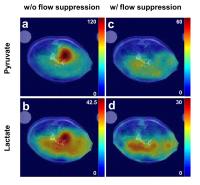 |
Optimization and application of bipolar gradient for
flow-suppressed hyperpolarized 13C CSI in mouse liver at 9.4T 
Hansol Lee1, Joonsung Lee2, Eunhae Joe1,
Seungwook Yang1, Jae Eun Song1,
Young-suk Choi3, Eunkyung Wang3,
Ho-Taek Song3, and Dong-Hyun Kim1
1Department of Electrical & Electronic
Engineering, Yonsei university, Seoul, Korea, Republic of, 2Center
for Neuroscience Imaging Research, Institute for Basic
Science, Sungkyunkwan University, Suwon, Korea, Republic of, 3Department
of Radiology, Yonsei University College of Medicine, Seoul,
Korea, Republic of
In hyperpolarized 13C MRI, high signal intensity
of vasculature can cause errors in quantification of
metabolites or conversion rate constants. The bipolar
gradient was used to suppress vascular signal for accurate
quantification. However, the velocity of vessel can vary
depending on anesthetic level and pulsation. Furthermore,
additional T2* relaxation signal loss can be
induced by delayed data acquisition in ultra-high field
(9.4T) due to short T2*. In this study, the
bipolar gradient was optimized to minimize additional signal
loss and mitigate variable velocity, then the optimized
bipolar gradient was implemented for hyperpolarized 13C
CSI and applied to mouse liver experiment.
|
|
2344.
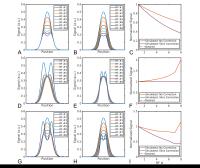 |
Mis-Estimation and Bias of Hyperpolarized ADC Measurements Due
to Slice Profile Effects 
Jeremy W Gordon1, Eugene Milshteyn1,
Irene Marco-Rius1, Michael Ohliger1,
Daniel B Vigneron1, and Peder EZ Larson1
1Radiology & Biomedical Imaging, University of
California - San Francisco, San Francisco, CA, United States
Hyperpolarized diffusion weighted imaging has the potential
to noninvasively assess transporter expression and probe
specific metabolite microenvironments. However, the
imperfect RF excitation profile and the transient,
non-recoverable hyperpolarization lead to non-uniform
depletion of Mz. After multiple RF pulses, this
results in excess signal at later excitations, potentially
biasing ADC estimation. Scaling the slice-select gradient
can correct for this deviation, minimizing bias and
providing more precise ADC measurements of hyperpolarized
substrates.
|
|
2345.
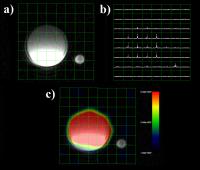 |
Design and test of a double-nuclear RF coil array for 1H MRI and
13C MRS at 7T
Omar Rutledge1, Tiffany Kwak1, Peng
Cao1, and Xiaoliang Zhang1
1Radiology and Biomedical Imaging, University of
California, San Francisco, San Francisco, CA, United States
RF coil operation at 7T is
fraught with technical challenges, making expansion of 7T
into clinical imaging difficult. In this work, a microstrip
transmission line and a wire loop coil were combined to form
a double-nuclear RF coil array for proton magnetic resonance
imaging and carbon magnetic resonance spectroscopy at the
ultrahigh magnetic field strength of 7T. Network analysis
revealed a high Q-factor and excellent decoupling between
the coils. Proton images and carbon spectra were acquired
with high sensitivity. The successful testing of this novel
double-coil array demonstrates the feasibility of this
design for multi-nuclear studies at 7T.
|
|
2346.
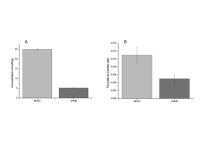 |
Feasibility of probing lactate metabolism and neuroprotection in
a mouse model of stroke using hyperpolarized 13C-lactate
Mor Mishkovsky1, Lara Buscemi2, Ximena
Castillo2, Mario Lepore3, Arnaud
Comment4, Lorenz Hirt2, and Jean-Noël
Hyacinthe5,6
1Laboratory of Functional and Metabolic Imaging,
Ecole Polytechnique Fédérale de Lausanne (EPFL), Lausanne,
Switzerland, 2Department
of Clinical Neurosciences, Centre Hospitalier Universitaire
Vaudois, Lausanne, Switzerland, 3Centre
d'Imagerie Biomédicale (CIBM), Ecole Polytechnique Fédérale
de Lausanne (EPFL), Lausanne, Switzerland, 4Institute
of Physics of Biological Systems, Ecole Polytechnique
Fédérale de Lausanne (EPFL), Lausanne, Switzerland, 5School
of Health Sciences - Geneva, University of Applied Sciences
and Arts Western Switzerland, Geneva, Switzerland, 6Image
Guided Intervention Laboratory, University of Geneva,
Geneva, Switzerland
Stroke is a major public health challenge in the context of
the current demographic changes. Among a wide range of
applications, hyperpolarized magnetic resonance enables in
vivo real-time measurement of biochemical transformations of
hyperpolarized 13C-labeled
precursors, including lactate, a known neuroprotectant in
stroke at the preclinical level. This study shows the
feasibility of measuring lactate metabolism in vivo in a
mouse model of stroke (MCAO) following intravenous injection
of hyperpolarized L-[1-13C]lactate. Calculated
pyruvate-to-lactate ratio shows an increased labeling of the
pyruvate pool in MCAO when compared to sham. This
feasibility study suggests new perspectives to understand
lactate biodistribution and its neuroprotective effect in
stroke.
|
|
2347.
 |
Robust, Quantitative Methods Applied to Clinical Hyperpolarized
C-13 MR of Prostate Cancer Patients 
Peder Eric Zufall Larson1, Jeremy Gordon1,
John Maidens2, Murat Arcak2, Hsin-Yu
Chen1, Galen Reed1, Ilwoo Park1,
Rahul Aggarwal3, Robert Bok1, Sarah J
Nelson1, John Kurhanewicz1, and Daniel
B Vigneron1
1Radiology and Biomedical Imaging, University of
California - San Francisco, San Francisco, CA, United
States, 2Electrical
Engineering & Computer Sciences, University of California -
Berkeley, Berkeley, CA, United States, 3Medicine,
University of California - San Francisco, San Francisco, CA,
United States
Clinical evaluation of metabolic MRI using hyperpolarized
C-13 agents has begun in earnest at multiple sites with the
availability of the SpinLab commercial polarizer. For this
technology to succeed, robust imaging and analysis methods
for quantification of metabolic activity are required. We
have developed and are applying efficient dynamic imaging
methods, robust kinetic models, and specialized calibration
schemes to enable accurate and reproducible quantification
in clinical hyperpolarized MR studies.
|
|
2348.
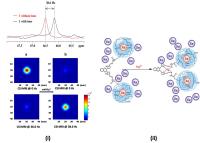 |
A Molecular Imaging Approach to Mercury Sensing Based on
Hyperpolarized 129Xe Molecular Clamp Probe
Qianni Guo1, Qingbin Zeng1, Weiping
Jiang1, Xiaoxiao Zhang1, Qing Luo1,
and Xin Zhou1
1Wuhan Institute of Physics and Mathematics,
Chinese Academy of Sciences, Wuhan, China, People's Republic
of
Mercury contamination is widespread and arises from a
variety of natural sources.We propose the use of
hyperpolarized 129Xe
nuclear magnetic resonance (NMR) spectroscopy for the
sensitive detection of Hg2+ions in aqueous
solution.We develop a biosensor whose molecular structure is
like a clamp. When interact with Hg2+ in
aqueous solution, the molecular structure of the biosensor
could be changed as a clamp from “open” to “closed”. This
molecular structure change causes the distance between the
two cryptophane cages of the biosensor become closer, and
the electron cloud of them overlapped. As a result,
comparing with normal downfield chemical shifts of the
reported xenon biosensors formetallic ions, the Xe caged in
the cryptophane moiety shows a upfield chemical shift change
from 66.5 ppm to 66.1 ppm. Images were obtained using a CSI
method preciously used for clinical MRI.
|
|
2349.
 |
Investigating Spectral Selectivity of the bSSFP Sequence for
High Resolution 3D Dynamic Hyperpolarized 13C MRI at 3T Using
C2-Pyruvate and Urea 
Eugene Milshteyn1, Cornelius von Morze1,
Hong Shang1, Galen D Reed2, and Daniel
B Vigneron1
1Radiology and Biomedical Imaging, UCSF, San
Francisco, CA, United States, 2HeartVista,
Menlo Park, CA, United States
Hyperpolarized 13C
MR imaging can provide simultaneous assessments of
metabolism and perfusion to study disease processes. High
resolution dynamic imaging is needed to fully understand
these processes, but is challenging, especially on
clinically relevant systems. This project investigated new
methods for spectral selectivity with SNR-efficient bSSFP
sequences to provide improved high resolution 3D dynamic in
vivo HP 13C
MR imaging at 3T.
|
|
2350.
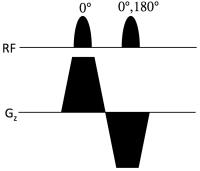 |
Toward Spectroscopically Selective Imaging of Hyperpolarized
Pyruvate and its Metabolites Using Binomial Pulses In Balanced
Steady-State Free Precession
Gopal Varma1, Patricia Coutinho de Souza1,
Leo Tsai1, Rupal Bhatt2, and Aaron
Grant1
1Radiology, Beth Israel Deaconess Medical Center
and Harvard Medical School, Boston, MA, United States, 2Medicine,
Beth Israel Deaconess Medical Center and Harvard Medical
School, Boston, MA, United States
Balanced steady-state free-precession (bSSFP) offers high
sensitivity and good temporal resolution, and makes
efficient use of hyperpolarized magnetization. Several
strategies for spectroscopically selective imaging with
bSSFP have been proposed [1-5]. Here we investigate the use
of simple binomial excitation pulses to selectively null the
signals from either pyruvate or lactate, the two dominant
metabolites in tumors, thereby obtaining images that are
dominated by either lactate or pyruvate, respectively. The
method is robust to off-resonance effects, and can be used
to augment existing spectroscopic bSSFP techniques.
|
|
